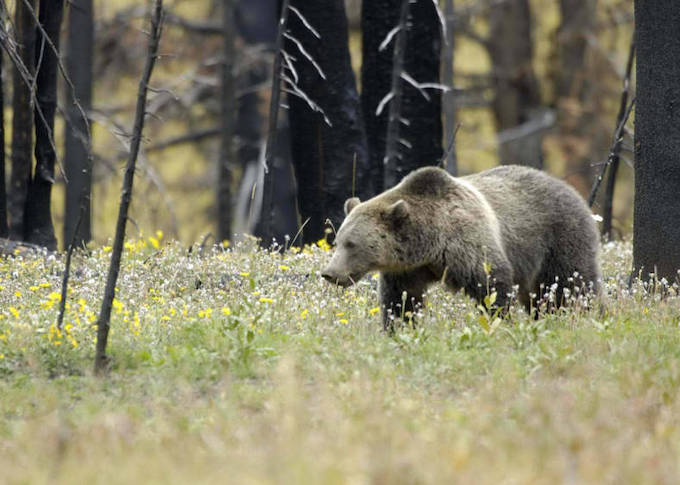Conservation Groups’ Lawsuit Halts Clearcutting Project in Critical Cabinet-Yaak Grizzly Habitat

Photo: National Park Service.
One would have to be mighty gullible to believe the Forest Service’s claim that the Knotty Pine Project would benefit the declining population of Cabinet-Yaak grizzly bears because the 5,000 acres of logging with massive new clearcuts would allow more huckleberries to grow.
If that sounds too outrageous to believe, that’s because it is and is the same reaction a federal judge had when presented with the science and facts by the Alliance for the Wild Rockies, Center for Biological Diversity, and their co-plaintiffs. The evidence was so clear and convincing, the Court completely halted the project in its tracks.
The Cabinet-Yaak grizzly bears are the most isolated and imperiled population in the Northern Rockies and are considered crucial to the on-going efforts to recover the species. Yet the U.S. Fish & Wildlife Service has documented a consistent decline in population numbers. In 2018 the Agency counted 54 grizzlies in its monitoring report. In 2019 only 50, down to 45 in 2020 and the 2021 estimate was only 42 bears. That’s a stunning crash of nearly one-quarter of the population in only four years!
According to published, peer-reviewed scientific literature, losing three Cabinet-Yaak female grizzlies in a single year will likely result in a population decline. That’s particularly troubling since scientists have determined that an increased loss of even one adult female bear every 2-5 years can dramatically escalate risks of inbreeding and population extirpation. The Knotty Pine Project area is home to at least four female grizzly bears and the U.S. Forest Service and U.S. Fish & Wildlife Service have determined that the Project impairs female grizzly bears’ ability to breed, protect and shelter cubs for years.
As shown by irrefutable evidence, the Cabinet-Yaak grizzly population is failing every recovery target and goal. It is failing the target for females with cubs; the target for distribution of females with cubs; the female mortality limit and the mortality limit for all bears – which is 0 mortalities until a minimum of 100 bears is reached. Yet the 2022 monitoring report found the mortalities include three female grizzlies between 2016 and 2021 and three more dead females and a male as of October 2022. The Knotty Pine Project would exacerbate the problem.
Logging and illegal road use leading causes of grizzly mortality
Despite the Forest Service’s specious rationale for the Project’s logging and road-building, one of the leading causes of grizzly mortality is high road densities. The Kootenai National Forest is a prime example, and Knotty Pine would have constructed and reconstructed a significant number of permanent roads to access the 56,000 acres of the project area.
It’s well-documented that roads – legal or illegal – is the most critical factor for grizzly bear survival and recovery. Not only do roads fragment and reduce secure habitat, when it comes to human-caused mortality, most grizzly bears are shot by poachers within 1/3 mile of roads, many in clearcuts where there are no trees left to hide them.
Adding to the permanent roads, the Court also found that the Forest Service failed to keep illegal traffic off “closed” roads or stop the creation of new illegal roads. Given these facts, the Court ruled the agency failed to adequately account for the harm to grizzly bears from both legal and illegal road use.
Project not popular locally
The Forest Service often claims widespread local support for logging projects. But that is not true for the Knotty Pine Project. Due to overwhelming and vocal opposition, the district ranger had an enforcement officer shut down a public meeting at the McCormick schoolyard on this project in 2021. According to one Forest Service official, it quickly turned into one of the most heated meetings she had attended in her career.
Conclusion
The Alliance and its conservation co-plaintiffs sought the Preliminary Injunction halting the project for one simple reason – all the evidence over the years concludes the Cabinet-Yaak grizzlies will be extirpated if logging and road-building in their limited habitat continues.
The Forest Service needs to quit lying to the public and breaking the law by pretending more logging and bulldozing roads is the answer to every problem while driving Cabinet-Yaak grizzlies into extinction. The Alliance is committed to holding the agency to the letter of the law and we welcome your support in our on-going effort to recover this perilously threatened population of grizzly bears.
No comments:
Post a Comment